Abstract
Metallic elements contained in coal, oil and gasoline are mobilized by combustion processes and may be emitted into the atmosphere, mainly as components of submicron particles. The information about the amounts, composition and form of metal compounds is reviewed for some fuels and combustion processes. Since metal compounds are always contained in urban air pollutants, they have to be considered whenever an evaluation of biological impact of air pollutants is made. The value of currently used bioassays for the evaluation of the role of trace metal compounds, either as major biologically active components or as modifiers of biological effects of organic compounds is assessed. The whole animal bioassays for carcinogenicity do not seem to be an appropriate approach. They are costly, time-consuming and not easily amenable to the testing of complex mixtures. Some problems related to the application and interpretation of short-term bioassays are considered, and the usefulness of such bioassays for the evaluation of trace metal components contained in complex air pollution mixtures is examined.
Full text
PDF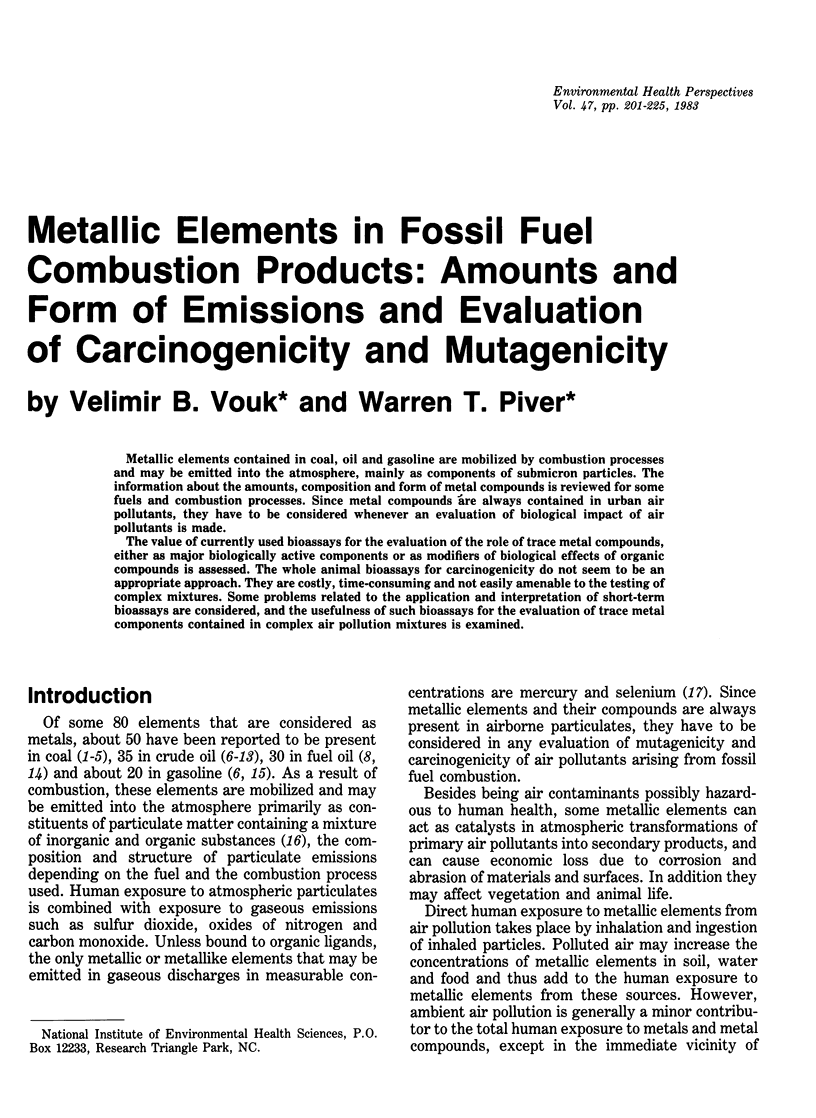
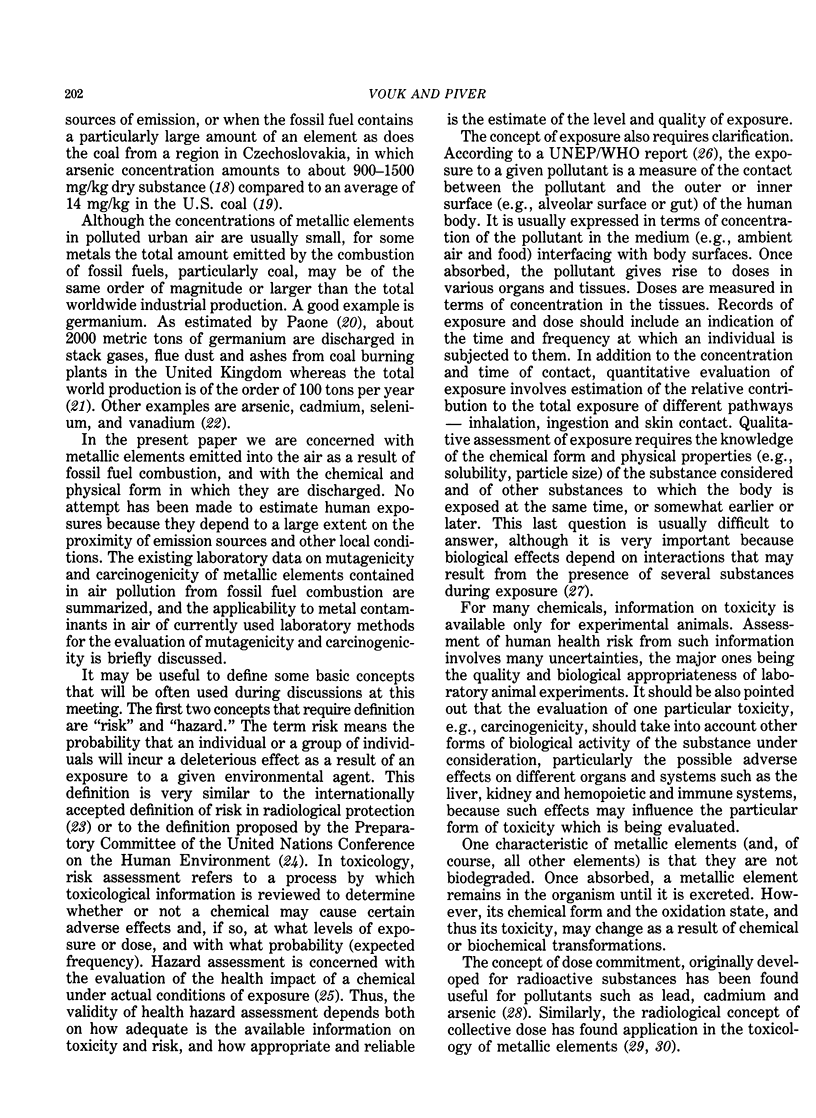
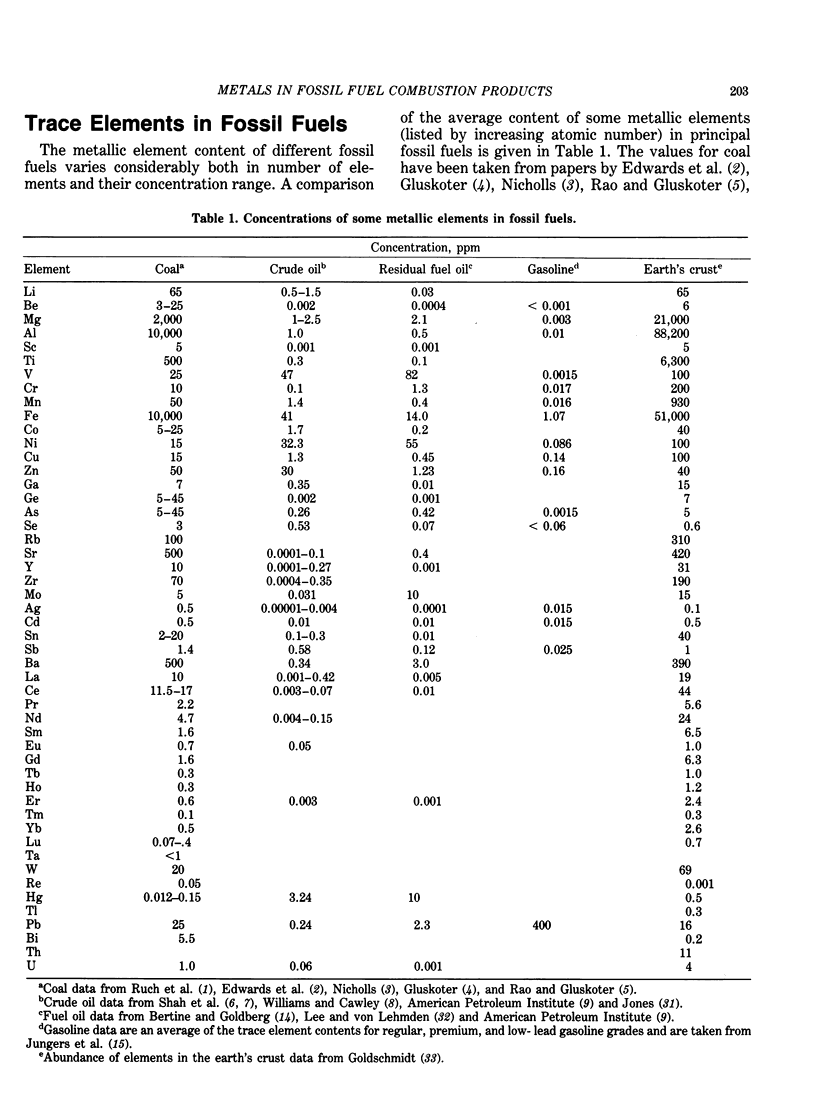
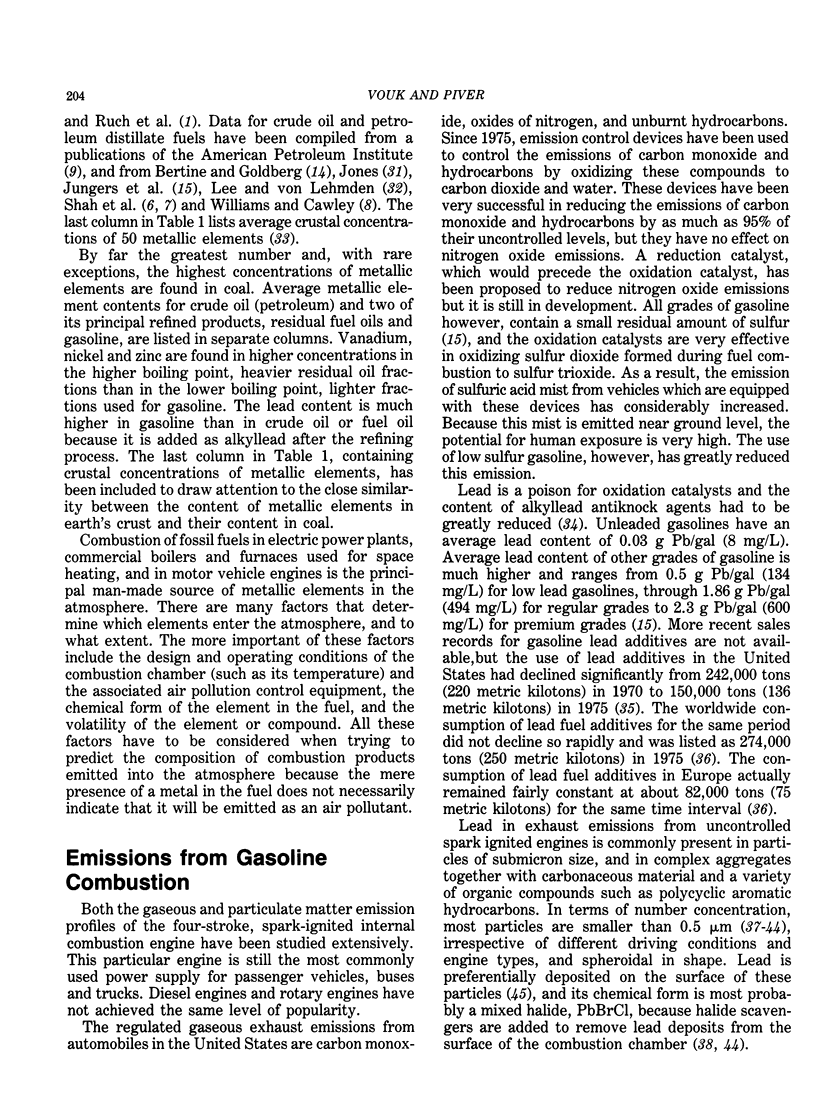
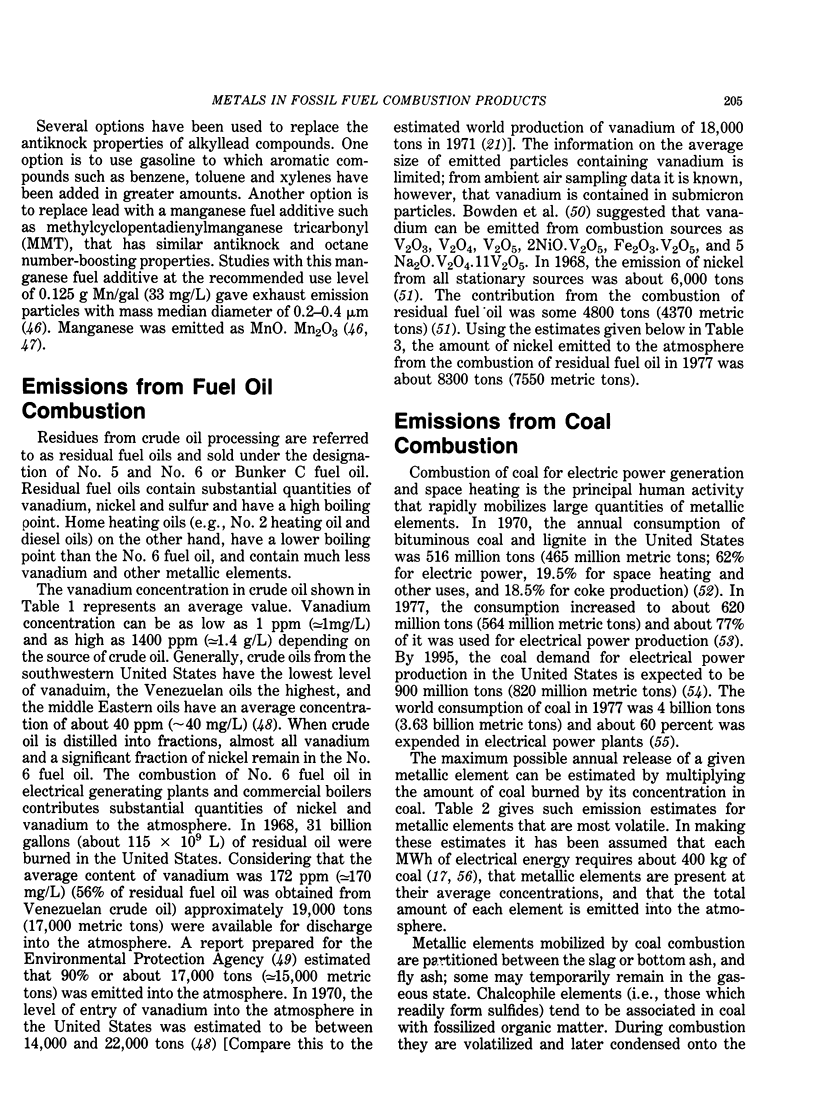
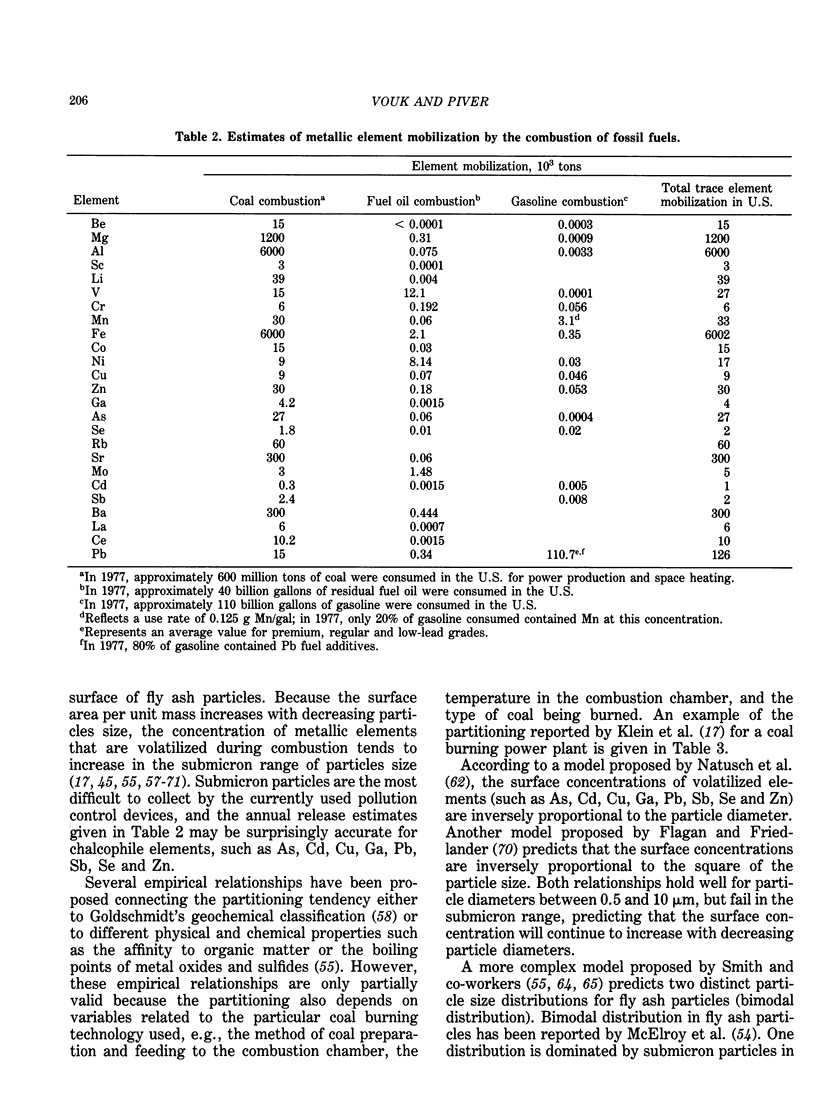
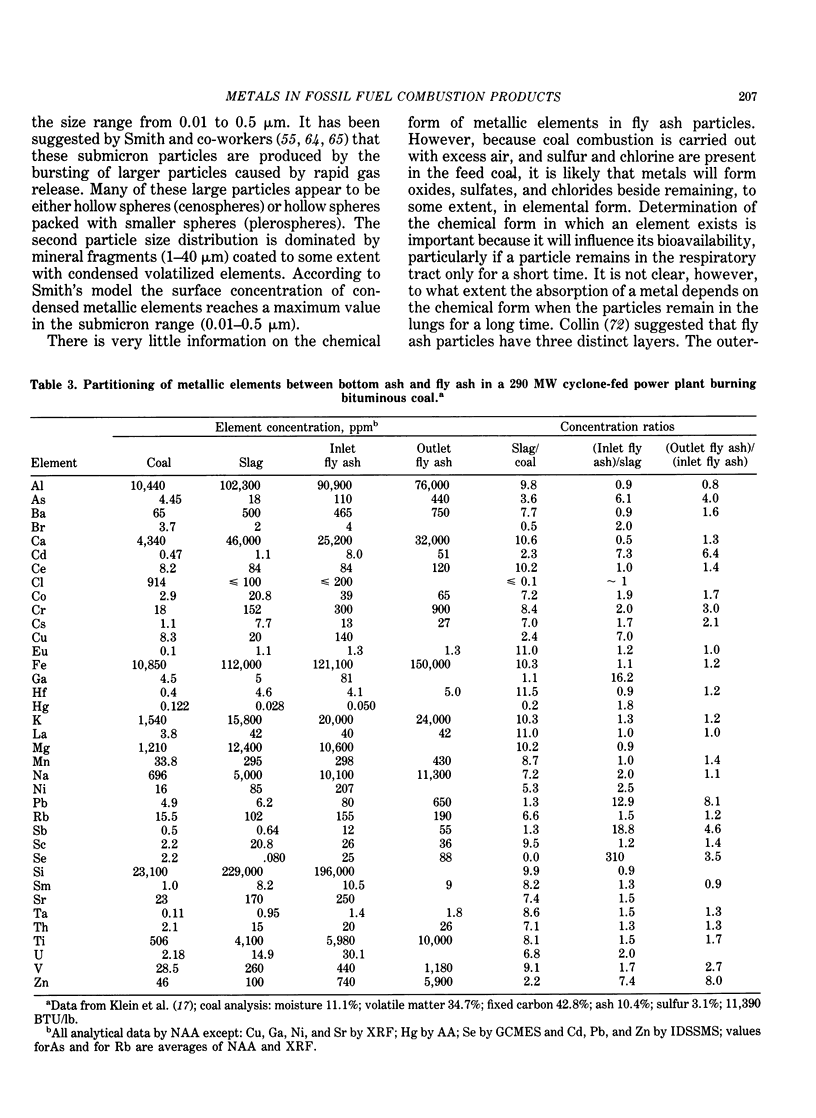
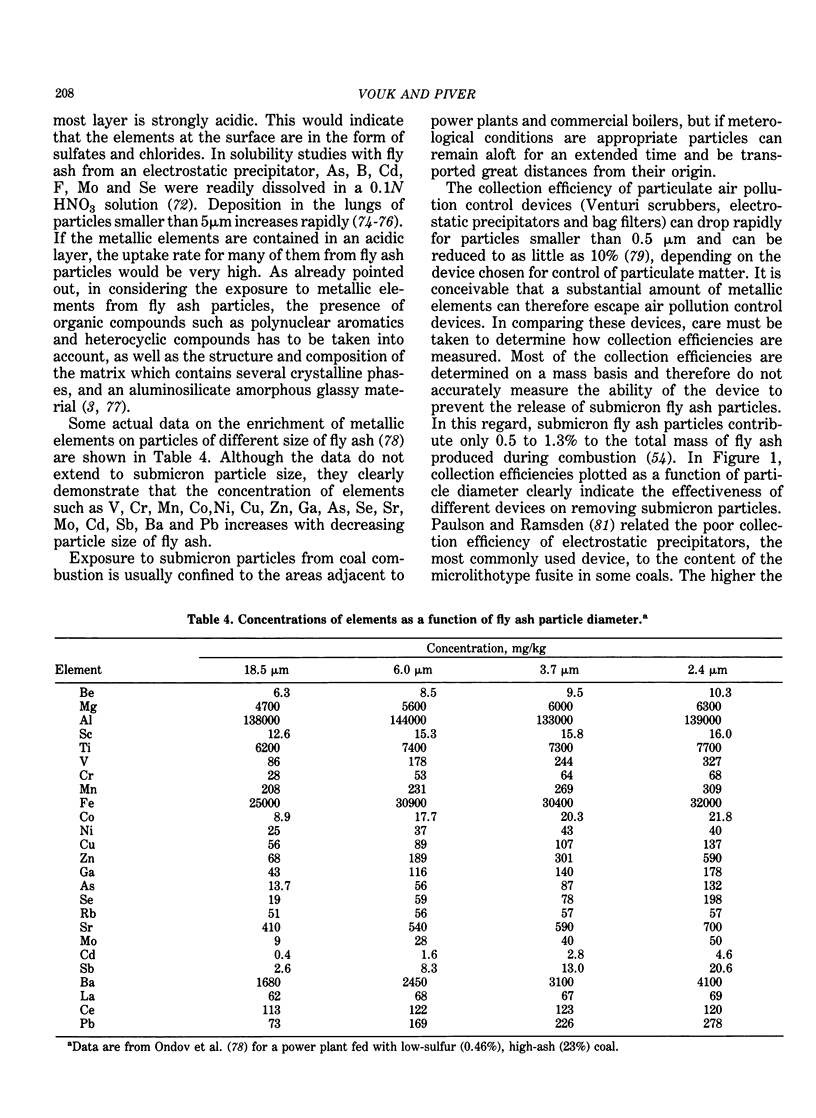
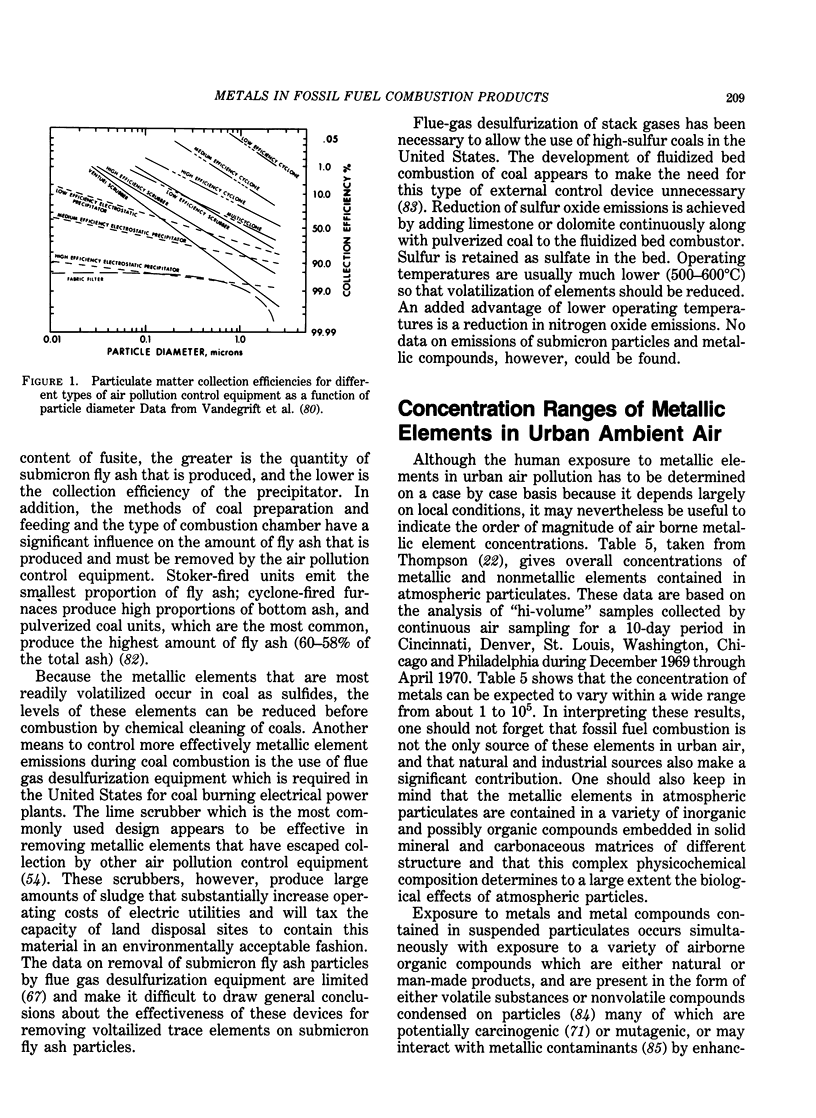
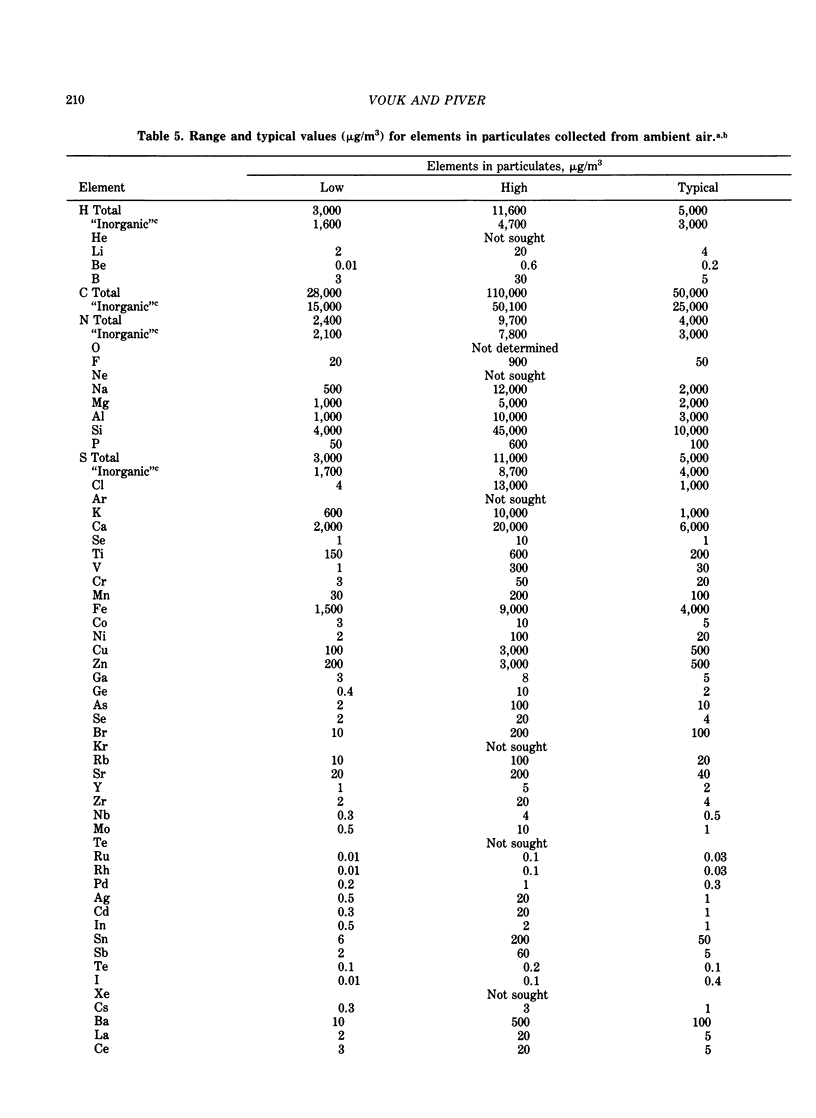
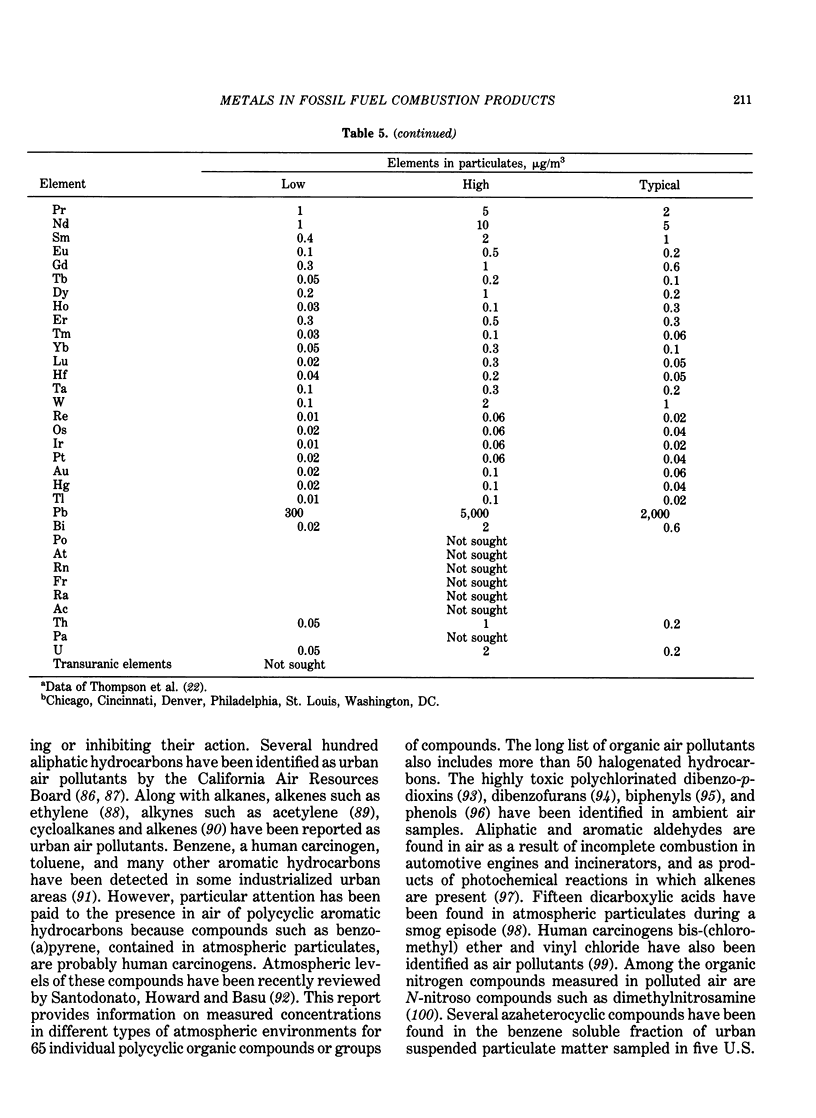

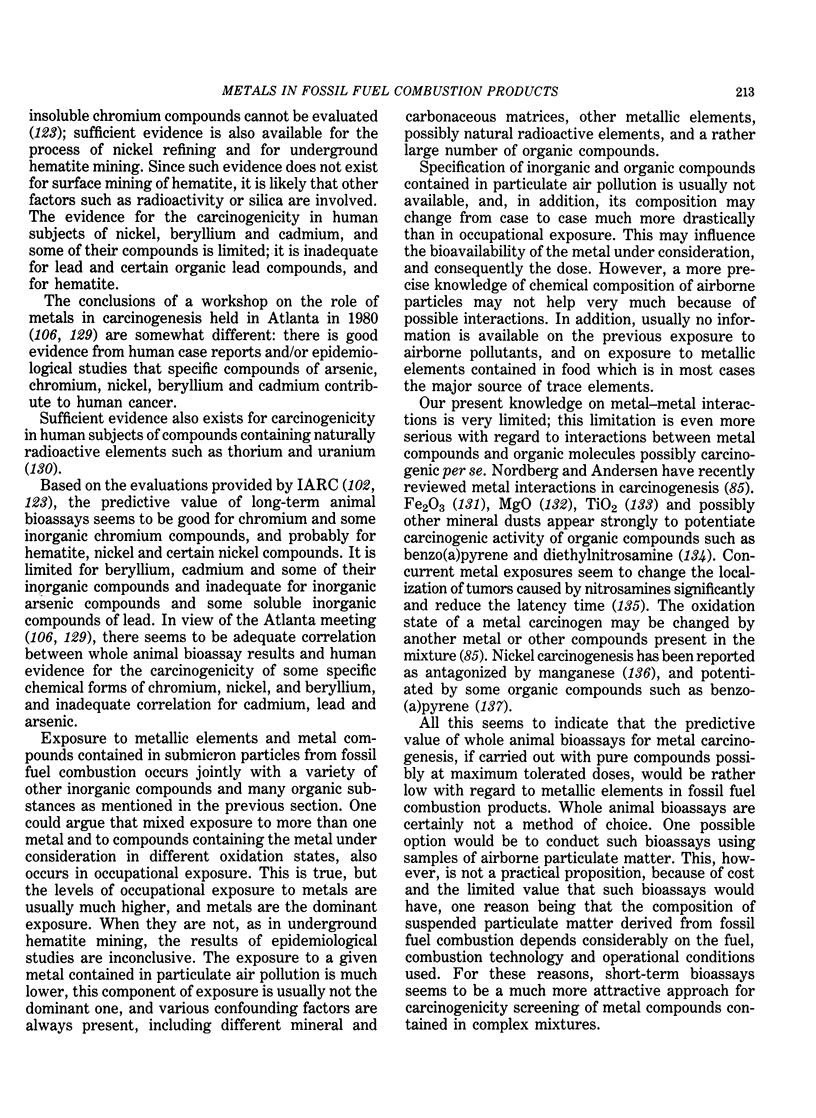
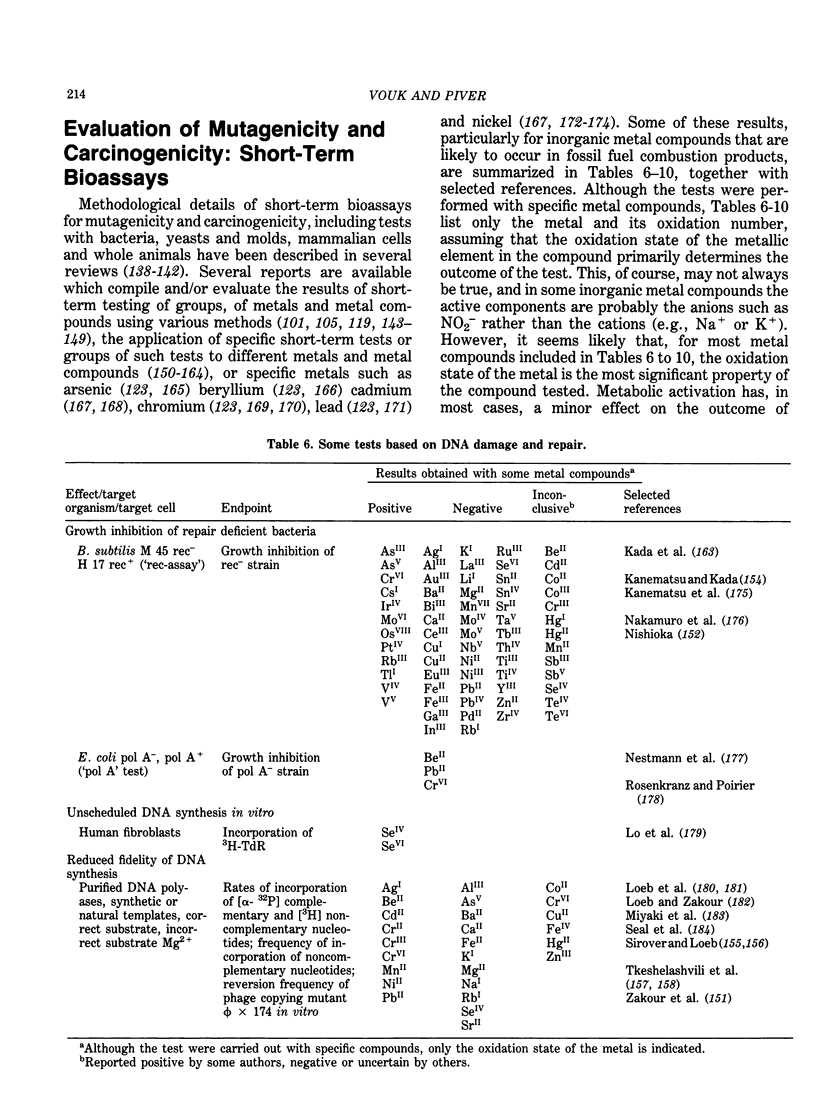
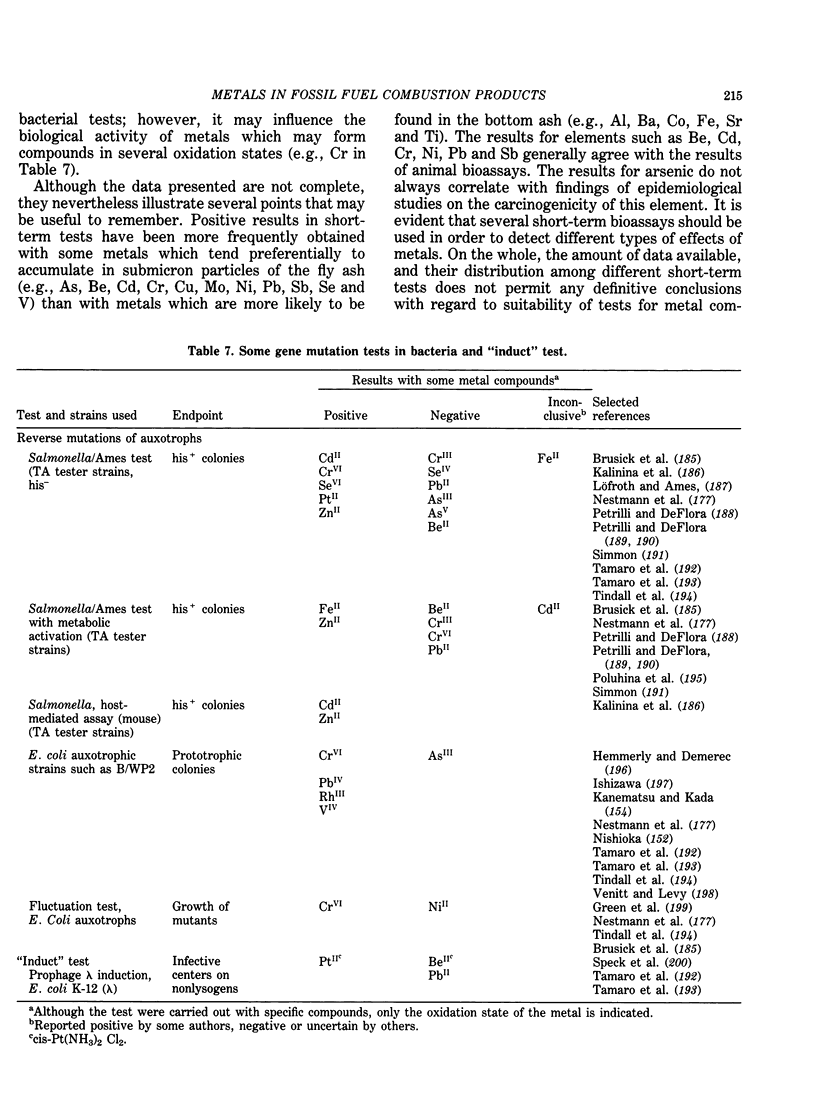
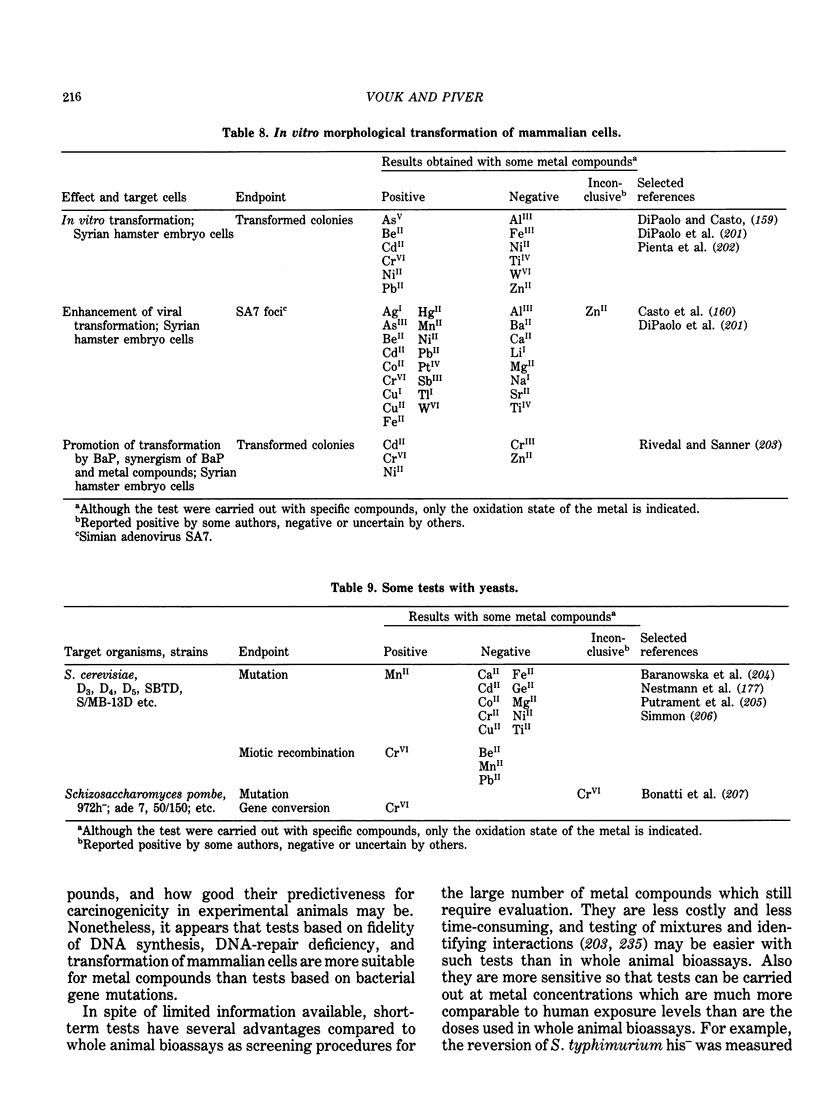
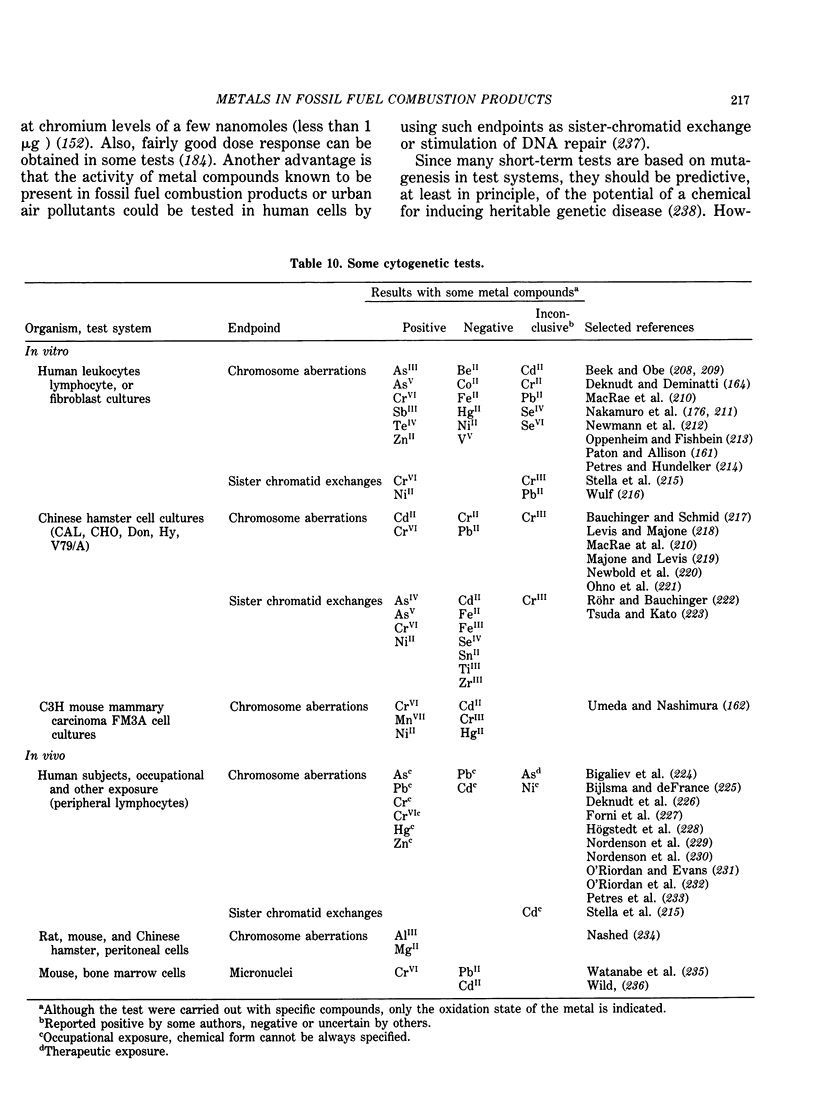
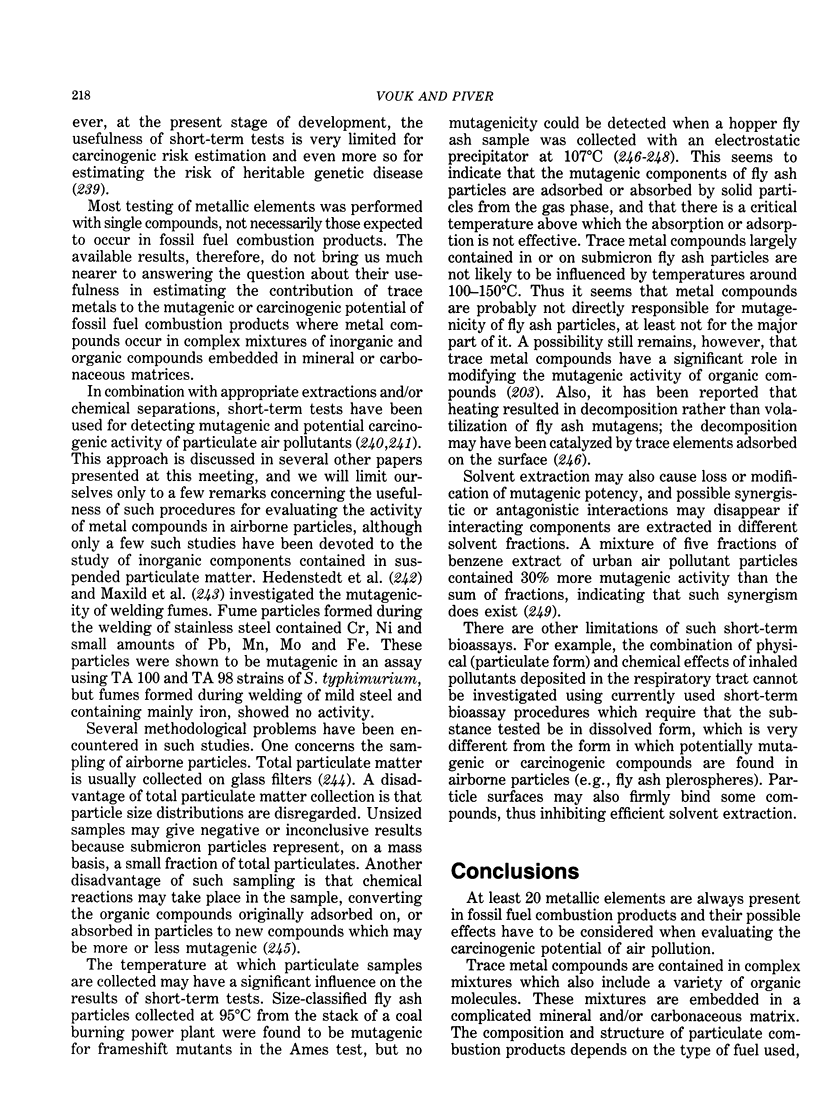
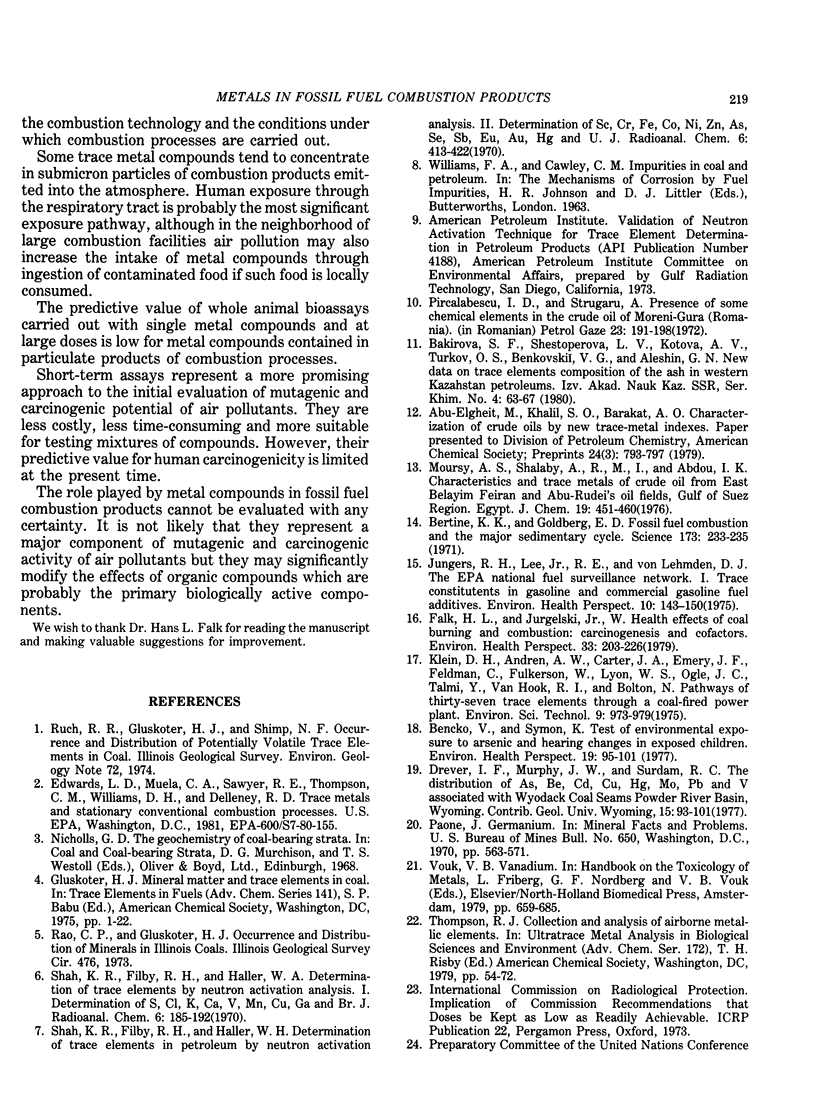
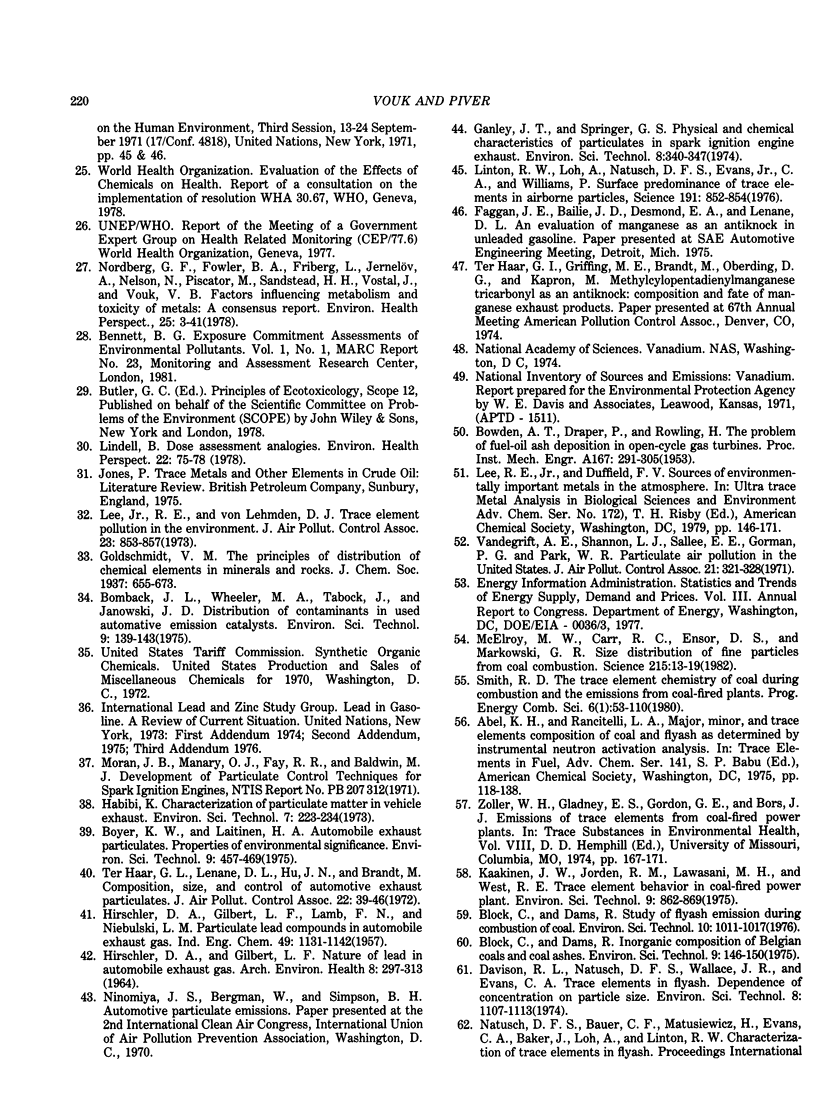
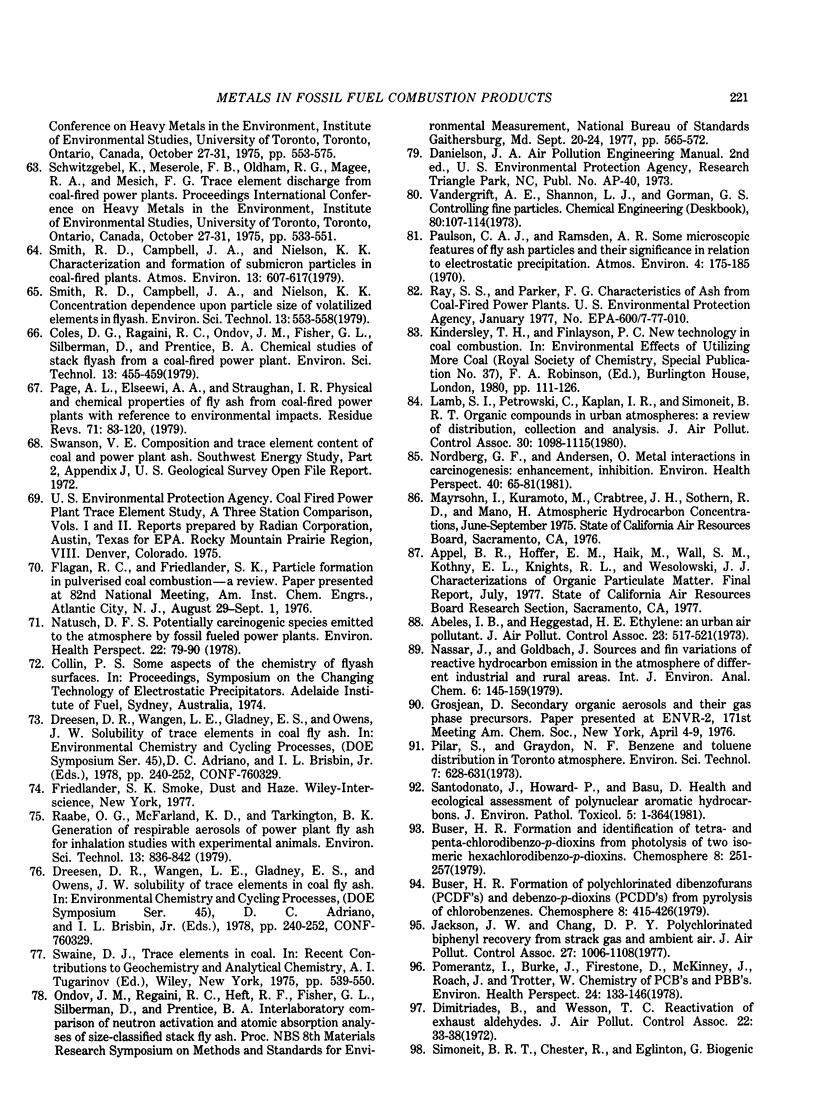
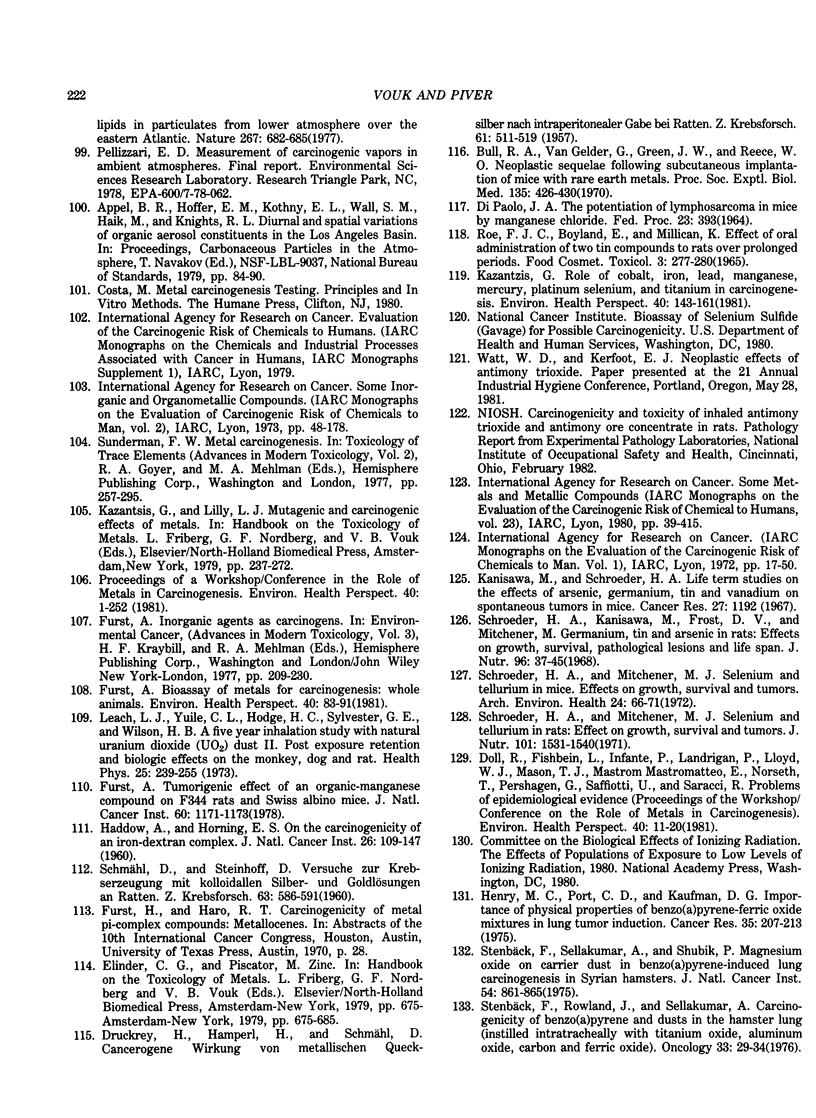
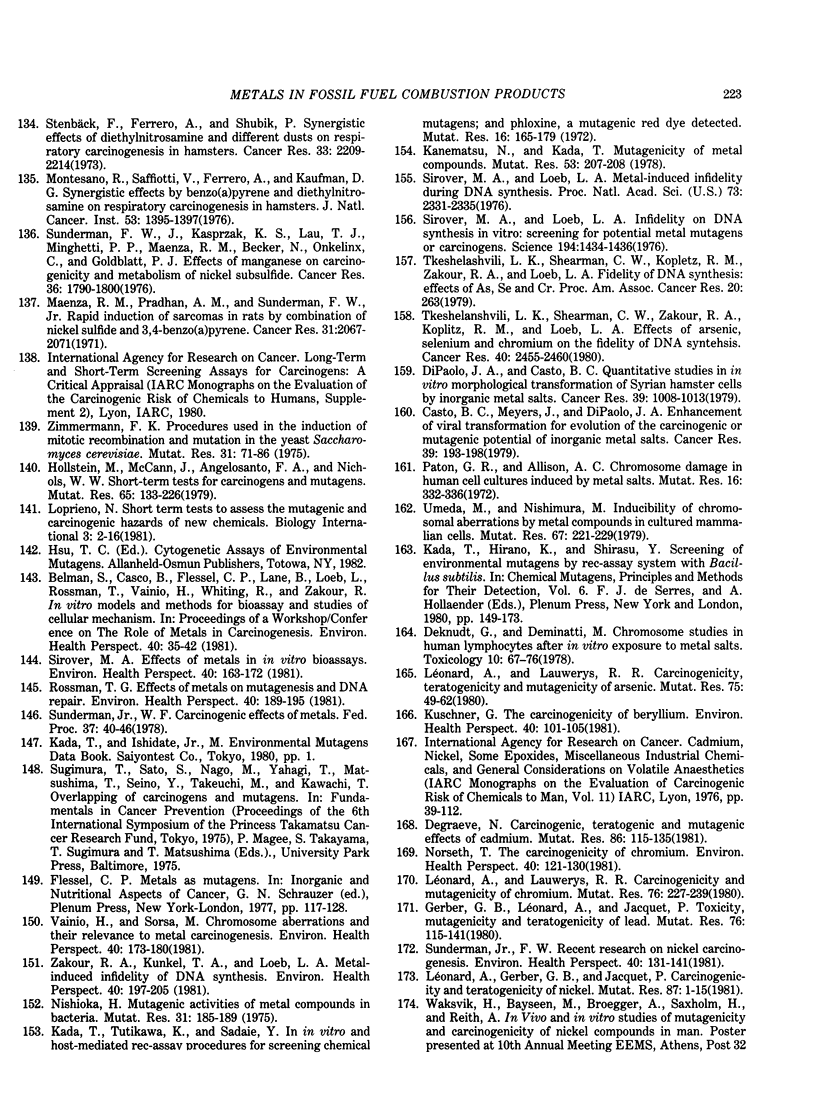
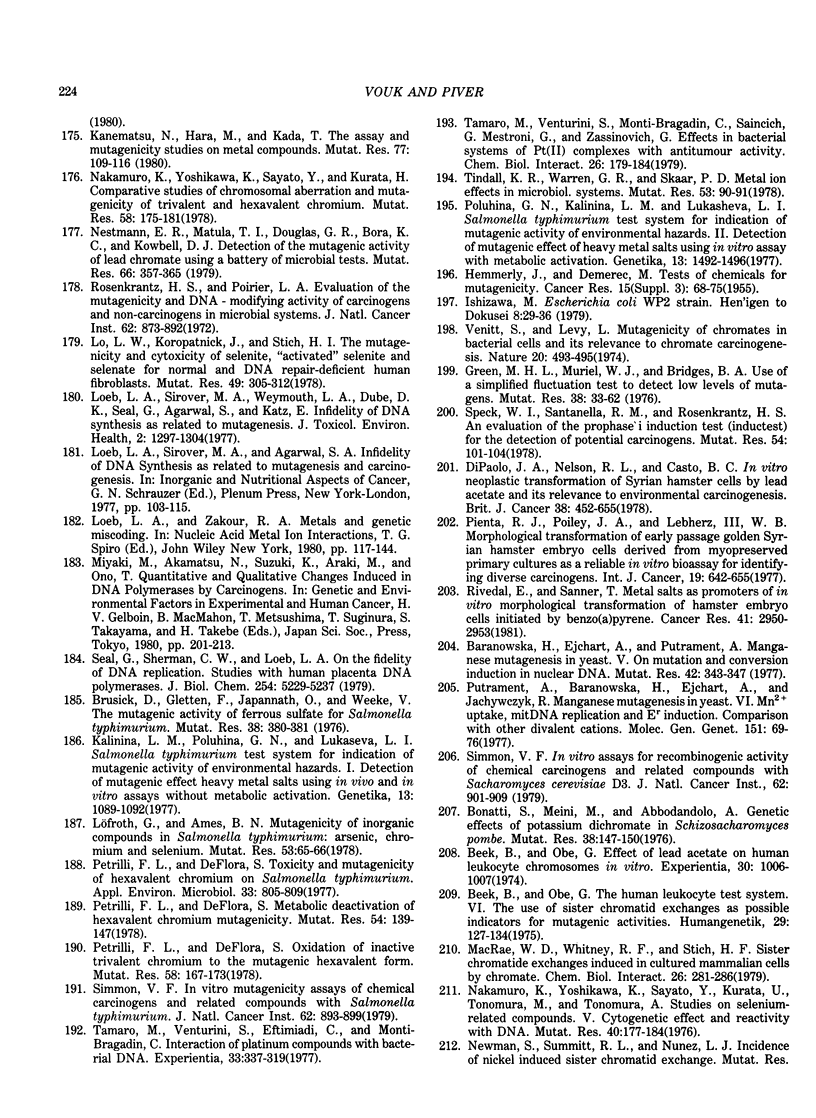
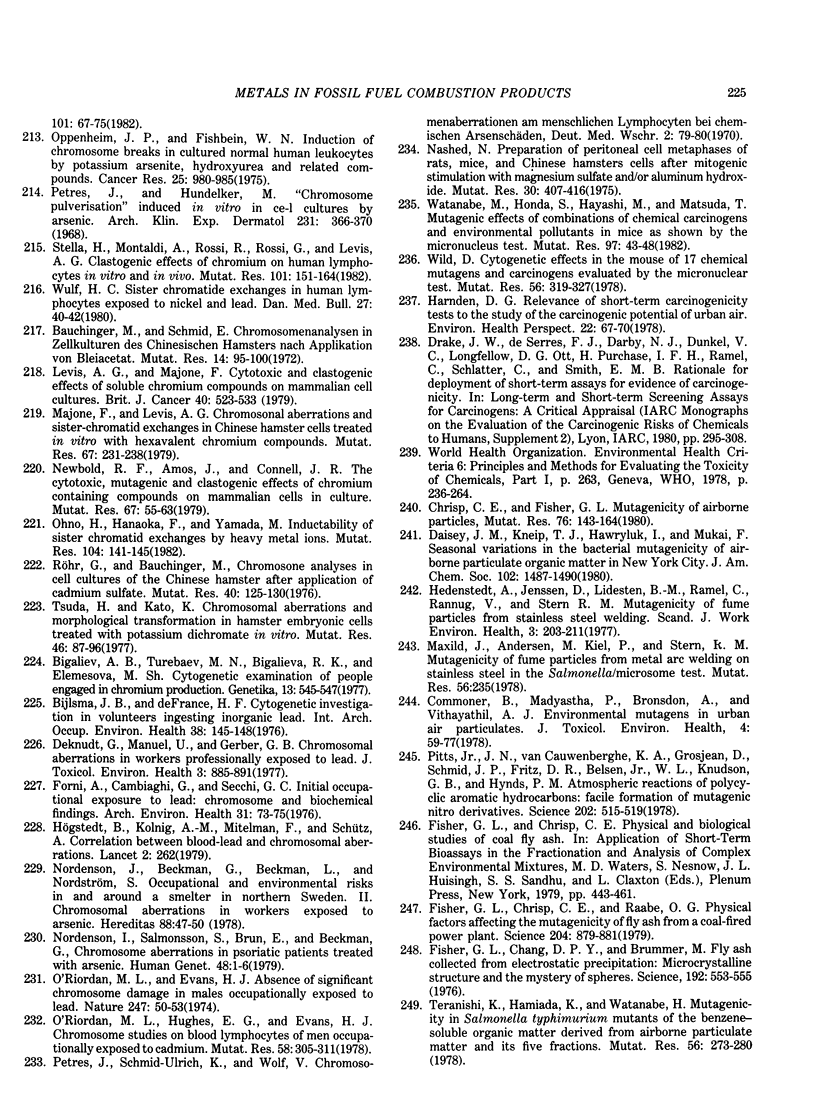
Selected References
These references are in PubMed. This may not be the complete list of references from this article.
- Abeles F. B., Heggestad H. E. Ethylene: an urban air pollutant. J Air Pollut Control Assoc. 1973 Jun;23(6):517–521. doi: 10.1080/00022470.1973.10469798. [DOI] [PubMed] [Google Scholar]
- Ball R. A., Van Gelder G., Green J. W., Jr, Reece W. O. Neoplastic sequelae following subcutaneous implantation of mice with rare earth metals. Proc Soc Exp Biol Med. 1970 Nov;135(2):426–430. doi: 10.3181/00379727-135-35067. [DOI] [PubMed] [Google Scholar]
- Baranowska H., Ejchart A., Putrament A. Manganese mutagenesis in yeast. V. On mutation and conversion induction in nuclear DNA. Mutat Res. 1977 Mar;42(3):343–348. doi: 10.1016/s0027-5107(77)80038-9. [DOI] [PubMed] [Google Scholar]
- Bauchinger M., Schmid E. Chromosomenanalysen in Zellkulturen des Chinesichen Hamsters nach Applikation von Bleiacetat. Mutat Res. 1972 Jan;14(1):95–100. doi: 10.1016/0027-5107(72)90110-8. [DOI] [PubMed] [Google Scholar]
- Beek B., Obe G. Effect of lead acetate on human leukocyte chromosomes in vitro. Experientia. 1974 Sep 15;30(9):1006–1007. doi: 10.1007/BF01938974. [DOI] [PubMed] [Google Scholar]
- Beek B., Obe G. The human leukocyte test system. VI. The use of sister chromatid exchanges as possible indicators for mutagenic activities. Humangenetik. 1975 Sep 10;29(2):127–134. doi: 10.1007/BF00430349. [DOI] [PubMed] [Google Scholar]
- Bencko V., Symon K. Test of environmental exposure to arsenic and hearing changes in exposed children. Environ Health Perspect. 1977 Aug;19:95–101. doi: 10.1289/ehp.771995. [DOI] [PMC free article] [PubMed] [Google Scholar]
- Bertine K. K., Goldberg E. D. Fossil fuel combustion and the major sedimentary cycle. Science. 1971 Jul 16;173(3993):233–235. doi: 10.1126/science.173.3993.233. [DOI] [PubMed] [Google Scholar]
- Bijlsma J. B., de France H. F. Cytogenetic investigations in volunteers ingesting inorganic lead. Int Arch Occup Environ Health. 1976 Dec 15;38(2):145–148. doi: 10.1007/BF00378625. [DOI] [PubMed] [Google Scholar]
- Bonatti S., Meini M., Abbondandolo A. Genetic effects of potassium dichromate in Schizosaccharomyces pombe. Mutat Res. 1976 Apr;38(2):147–150. [PubMed] [Google Scholar]
- Casto B. C., Meyers J., DiPaolo J. A. Enhancement of viral transformation for evaluation of the carcinogenic or mutagenic potential of inorganic metal salts. Cancer Res. 1979 Jan;39(1):193–198. [PubMed] [Google Scholar]
- Chrisp C. E., Fisher G. L. Mutagenicity of airborne particles. Mutat Res. 1980 Sep;76(2):143–164. doi: 10.1016/0165-1110(80)90007-x. [DOI] [PubMed] [Google Scholar]
- Commoner B., Madyastha R., Bronsdon A., Vithayathil A. J. Environmental mutagens in urban air particulates. J Toxicol Environ Health. 1978 Jan;4(1):59–77. doi: 10.1080/15287397809529645. [DOI] [PubMed] [Google Scholar]
- DRUCKREY H., HAMPERL H., SCHMAHL D. Cancerogene Wirkung von metallischem Quecksilber nach intraperitonealer Gabe bei Ratten. Z Krebsforsch. 1957;61(5):511–519. [PubMed] [Google Scholar]
- Degraeve N. Carcinogenic, teratogenic and mutagenic effects of cadmium. Mutat Res. 1981 Jan;86(1):115–135. doi: 10.1016/0165-1110(81)90035-x. [DOI] [PubMed] [Google Scholar]
- Deknudt G., Manuel Y., Gerber G. B. Chromosomal aberrations in workers professionally exposed to lead. J Toxicol Environ Health. 1977 Dec;3(5-6):885–891. doi: 10.1080/15287397709529622. [DOI] [PubMed] [Google Scholar]
- DiPaolo J. A., Casto B. C. Quantitative studies of in vitro morphological transformation of Syrian hamster cells by inorganic metal salts. Cancer Res. 1979 Mar;39(3):1008–1013. [PubMed] [Google Scholar]
- Dimitriades B., Wesson T. C. Reactivities of exhaust aldehydes. J Air Pollut Control Assoc. 1972 Jan;22(1):33–38. doi: 10.1080/00022470.1972.10469606. [DOI] [PubMed] [Google Scholar]
- Dipaolo J. A., Nelson R. L., Casto B. C. In vitro neoplastic transformation of Syrian hamster cells by lead acetate and its relevance to environmental carcinogenesis. Br J Cancer. 1978 Sep;38(3):452–455. doi: 10.1038/bjc.1978.228. [DOI] [PMC free article] [PubMed] [Google Scholar]
- Falk H. L., Jurgelski W., Jr Health effects of coal mining and combustion: carcinogens and cofactors. Environ Health Perspect. 1979 Dec;33:203–226. doi: 10.1289/ehp.7933203. [DOI] [PMC free article] [PubMed] [Google Scholar]
- Fisher G. L., Chang D. P., Brummer M. Fly ash collected from electrostatic precipitators: microcrystalline structures and the mystery of the spheres. Science. 1976 May 7;192(4239):553–555. doi: 10.1126/science.192.4239.553. [DOI] [PubMed] [Google Scholar]
- Fisher G. L., Chrisp C. E., Raabe O. G. Physical factors affecting the mutagenicity of fly ash from a coal-fired power plant. Science. 1979 May 25;204(4395):879–881. doi: 10.1126/science.375394. [DOI] [PubMed] [Google Scholar]
- Furst A. Bioassay of metals for carcinogenesis: whole animals. Environ Health Perspect. 1981 Aug;40:83–91. doi: 10.1289/ehp.814083. [DOI] [PMC free article] [PubMed] [Google Scholar]
- Furst A. Tumorigenic effect of an organomanganese compound on F344 rats and Swiss albino mice. J Natl Cancer Inst. 1978 May;60(5):1171–1173. doi: 10.1093/jnci/60.5.1171. [DOI] [PubMed] [Google Scholar]
- Gerber G. B., Léonard A., Jacquet P. Toxicity, mutagenicity and teratogenicity of lead. Mutat Res. 1980 Sep;76(2):115–141. doi: 10.1016/0165-1110(80)90006-8. [DOI] [PubMed] [Google Scholar]
- Green M. H., Muriel W. J., Bridges B. A. Use of a simplified fluctuation test to detect low levels of mutagens. Mutat Res. 1976 Feb;38(1):33–42. doi: 10.1016/0165-1161(76)90077-7. [DOI] [PubMed] [Google Scholar]
- HIRSCHLER D. A., GILBERT L. F. NATURE OF LEAD IN AUTOMOBILE EXHAUST GAS. Arch Environ Health. 1964 Feb;8:297–313. doi: 10.1080/00039896.1964.10663670. [DOI] [PubMed] [Google Scholar]
- Haar GL Ter, Lenane D. L., Hu J. N., Brandt M. Composition, size and control of automotive exhaust particulates. J Air Pollut Control Assoc. 1972 Jan;22(1):39–46. doi: 10.1080/00022470.1972.10469607. [DOI] [PubMed] [Google Scholar]
- Harnden D. G. Relevance of short-term carcinogenicity tests to the study of the carcinogenic potential of urban air. Environ Health Perspect. 1978 Feb;22:67–70. doi: 10.1289/ehp.782267. [DOI] [PMC free article] [PubMed] [Google Scholar]
- Hedenstedt A., Jenssen D., Lidestein B-M, Ramel C., Rannug U., Stern R. M. Mutagenicity of fume particles from stainless steel welding. Scand J Work Environ Health. 1977 Dec;3(4):203–211. doi: 10.5271/sjweh.2776. [DOI] [PubMed] [Google Scholar]
- Henry M. C., Port C. D., Kaufman D. G. Importance of physical properties of benzo(a)pyrene-ferric oxide mixtures in lung tumor induction. Cancer Res. 1975 Jan;35(1):207–217. [PubMed] [Google Scholar]
- Hollstein M., McCann J., Angelosanto F. A., Nichols W. W. Short-term tests for carcinogens and mutagens. Mutat Res. 1979 Sep;65(3):133–226. doi: 10.1016/0165-1110(79)90014-9. [DOI] [PubMed] [Google Scholar]
- Högstedt B., Kolnig A. M., Mitelman F., Schütz A. Correlation between blood-lead and chromosomal aberrations. Lancet. 1979 Aug 4;2(8136):262–262. doi: 10.1016/s0140-6736(79)90281-2. [DOI] [PubMed] [Google Scholar]
- Jungers R. H., Lee R. E., Jr, von Lehmden D. J. The EPA National Fuels Surveillance Network. I. Trace constituents in gasoline and commercial gasoline fuel additives. Environ Health Perspect. 1975 Apr;10:143–150. doi: 10.1289/ehp.7510143. [DOI] [PMC free article] [PubMed] [Google Scholar]
- Kada T., Tutikawa K., Sadaie Y. In vitro and host-mediated "rec-assay" procedures for screening chemical mutagens; and phloxine, a mutagenic red dye detected. Mutat Res. 1972 Oct;16(2):165–174. doi: 10.1016/0027-5107(72)90177-7. [DOI] [PubMed] [Google Scholar]
- Kanematsu N., Hara M., Kada T. Rec assay and mutagenicity studies on metal compounds. Mutat Res. 1980 Feb;77(2):109–116. doi: 10.1016/0165-1218(80)90127-5. [DOI] [PubMed] [Google Scholar]
- Kanisawa M., Schroeder H. A. Life term studies on the effects of arsenic, germanium, tin, and vanadium on spontaneous tumors in mice. Cancer Res. 1967 Jul;27(7):1192–1195. [PubMed] [Google Scholar]
- Kazantzis G. Role of cobalt, iron, lead, manganese, mercury, platinum, selenium, and titanium in carcinogenesis. Environ Health Perspect. 1981 Aug;40:143–161. doi: 10.1289/ehp.8140143. [DOI] [PMC free article] [PubMed] [Google Scholar]
- Kuschner M. The carcinogenicity of beryllium. Environ Health Perspect. 1981 Aug;40:101–105. doi: 10.1289/ehp.8140101. [DOI] [PMC free article] [PubMed] [Google Scholar]
- Leach L. J., Yuile C. L., Hodge H. C., Sylvester G. E., Wilson H. B. A five-year inhalation study with natural uranium dioxide (UO2) dust. II. Postexposure retention and biologic effects in the monkey, dog and rat. Health Phys. 1973 Sep;25(3):239–258. doi: 10.1097/00004032-197309000-00003. [DOI] [PubMed] [Google Scholar]
- Lee R. E., Jr, Lehmden D. J. Trace metal pollution in the environment. J Air Pollut Control Assoc. 1973 Oct;23(10):853–857. doi: 10.1080/00022470.1973.10469854. [DOI] [PubMed] [Google Scholar]
- Levis A. G., Majone F. Cytotoxic and clastogenic effects of soluble chromium compounds on mammalian cell cultures. Br J Cancer. 1979 Oct;40(4):523–533. doi: 10.1038/bjc.1979.217. [DOI] [PMC free article] [PubMed] [Google Scholar]
- Lindell B. Dose assessment analogies. Environ Health Perspect. 1978 Feb;22:75–78. doi: 10.1289/ehp.782275. [DOI] [PMC free article] [PubMed] [Google Scholar]
- Linton R. W., Loh A., Natusch D. F., Evans C. A., Jr, Williams P. Surface predominance of trace elements in airborne particles. Science. 1976 Feb 27;191(4229):852–854. doi: 10.1126/science.1251197. [DOI] [PubMed] [Google Scholar]
- Lo L. W., Koropatnick J., Stich H. F. The mutagenicity and cytotoxicity of selenite, "activated" selenite and selenate for normal and DNA repair-deficient human fibroblasts. Mutat Res. 1978 Mar;49(3):305–312. doi: 10.1016/0027-5107(78)90103-3. [DOI] [PubMed] [Google Scholar]
- Loeb L. A., Sirover M. A., Weymouth L. A., Dube D. K., Seal G., Agarwal S. S., Katz E. Infidelity of DNA synthesis as related to mutagenesis and carcinogenesis. J Toxicol Environ Health. 1977 Jul;2(6):1297–1304. doi: 10.1080/15287397709529531. [DOI] [PubMed] [Google Scholar]
- Léonard A., Gerber G. B., Jacquet P. Carcinogenicity, mutagenicity and teratogenicity of nickel. Mutat Res. 1981 Jul;87(1):1–15. doi: 10.1016/0165-1110(81)90002-6. [DOI] [PubMed] [Google Scholar]
- Léonard A., Lauwerys R. R. Carcinogenicity and mutagenicity of chromium. Mutat Res. 1980 Nov;76(3):227–239. doi: 10.1016/0165-1110(80)90018-4. [DOI] [PubMed] [Google Scholar]
- Léonard A., Lauwerys R. R. Carcinogenicity, teratogenicity and mutagenicity of arsenic. Mutat Res. 1980 Jan;75(1):49–62. doi: 10.1016/0165-1110(80)90027-5. [DOI] [PubMed] [Google Scholar]
- MacRae W. D., Whiting R. F., Stich H. F. Sister chromatid exchanges induced in cultured mammalian cells by chromate. Chem Biol Interact. 1979 Aug;26(3):281–286. doi: 10.1016/0009-2797(79)90031-0. [DOI] [PubMed] [Google Scholar]
- Maenza R. M., Pradhan A. M., Sunderman F. W., Jr Rapid induction of sarcomas in rats by combination of nickel sulfide and 3,4-benzpyrene. Cancer Res. 1971 Dec;31(12):2067–2071. [PubMed] [Google Scholar]
- Majone F., Levis A. G. Chromosomal aberrations and sister-chromatid exchanges in Chinese hamster cells treated in vitro with hexavalent chromium compounds. Mutat Res. 1979 Jul;67(3):231–238. doi: 10.1016/0165-1218(79)90017-x. [DOI] [PubMed] [Google Scholar]
- Maxild J., Andersen M., Kiel P. Mutagenicity of fume particles from metal arc welding on stainless steel in the Salmonella/microsome test. Mutat Res. 1978 Jan;56(3):235–243. doi: 10.1016/0027-5107(78)90190-2. [DOI] [PubMed] [Google Scholar]
- McElroy M. W., Carr R. C., Ensor D. S., Markowski G. R. Size distribution of fine particles from coal combustion. Science. 1982 Jan 1;215(4528):13–19. doi: 10.1126/science.215.4528.13. [DOI] [PubMed] [Google Scholar]
- Montesano R., Saffiotti U., Ferrero A., Kaufman D. G. Synergistic effects of benzo(alpha)pyrene and diethylnitrosamine on respiratory carcinogenesis in hamsters. J Natl Cancer Inst. 1974 Nov;53(5):1395–1397. doi: 10.1093/jnci/53.5.1395. [DOI] [PubMed] [Google Scholar]
- Nakamuro K., Yoshikawa K., Sayato Y., Kurata H. Comparative studies of chromosomal aberration and mutagenicity of the trivalent and hexavalent chromium. Mutat Res. 1978 Nov;58(2-3):175–181. doi: 10.1016/0165-1218(78)90007-1. [DOI] [PubMed] [Google Scholar]
- Nakamuro K., Yoshikawa K., Sayato Y., Kurata H., Tonomura M. Studies on selenium-related compounds. V. Cytogenetic effect and reactivity with DNA. Mutat Res. 1976 Jul;40(3):177–184. doi: 10.1016/0165-1218(76)90042-2. [DOI] [PubMed] [Google Scholar]
- Nashed K. Preparation of peritoneal cell metaphases of rats, mice and chinese hamsters after mitogenic stimulation with magnesium sulfate and/or aluminum hydroxide. Mutat Res. 1975 Dec;30(3):407–416. [PubMed] [Google Scholar]
- Natusch D. F. Potentially carcinogenic species emitted to the atmosphere by fossil-fueled power plants. Environ Health Perspect. 1978 Feb;22:79–90. doi: 10.1289/ehp.782279. [DOI] [PMC free article] [PubMed] [Google Scholar]
- Nestmann E. R., Matula T. I., Douglas G. R., Bora K. C., Kowbel D. J. Detection of the mutagenic activity of lead chromate using a battery of microbial tests. Mutat Res. 1979 Apr;66(4):357–365. doi: 10.1016/0165-1218(79)90046-6. [DOI] [PubMed] [Google Scholar]
- Newbold R. F., Amos J., Connell J. R. The cytotoxic, mutagenic and clastogenic effects of chromium-containing compounds on mammalian cells in culture. Mutat Res. 1979 May;67(1):55–63. doi: 10.1016/0165-1218(79)90099-5. [DOI] [PubMed] [Google Scholar]
- Nishioka H. Mutagenic activities of metal compounds in bacteria. Mutat Res. 1975 Jun;31(3):185–189. doi: 10.1016/0165-1161(75)90088-6. [DOI] [PubMed] [Google Scholar]
- Nordberg G. F., Andersen O. Metal interactions in carcinogenesis: enhancement, inhibition. Environ Health Perspect. 1981 Aug;40:65–81. doi: 10.1289/ehp.814065. [DOI] [PMC free article] [PubMed] [Google Scholar]
- Nordenson I., Beckman G., Beckman L., Nordström S. Occupational and environmental risks in and around a smelter in northern Sweden. II. Chromosomal aberrations in workers exposed to arsenic. Hereditas. 1978;88(1):47–50. doi: 10.1111/j.1601-5223.1978.tb01601.x. [DOI] [PubMed] [Google Scholar]
- Norseth T. The carcinogenicity of chromium. Environ Health Perspect. 1981 Aug;40:121–130. doi: 10.1289/ehp.8140121. [DOI] [PMC free article] [PubMed] [Google Scholar]
- O'Riordan M. L., Evans H. J. Absence of significant chromosome damage in males occupationally exposed to lead. Nature. 1974 Jan 4;247(5435):50–53. doi: 10.1038/247050a0. [DOI] [PubMed] [Google Scholar]
- O'Riordan M. L., Hughes E. G., Evans H. J. Chromosome studies on blood lymphocytes of men occupationally exposed to cadmium. Mutat Res. 1978 Nov;58(2-3):305–311. doi: 10.1016/0165-1218(78)90023-x. [DOI] [PubMed] [Google Scholar]
- Ohno H., Hanaoka F., Yamada M. Inducibility of sister-chromatid exchanges by heavy-metal ions. Mutat Res. 1982 Apr;104(1-3):141–145. doi: 10.1016/0165-7992(82)90135-x. [DOI] [PubMed] [Google Scholar]
- Oppenheim J. J., Fishbein W. N. Induction of chromosome breaks in cultured normal human leukocytes by potassium arsenite, hydroxyurea and related compounds. Cancer Res. 1965 Aug;25(7):980–985. [PubMed] [Google Scholar]
- Paton G. R., Allison A. C. Chromosome damage in human cell cultures induced by metal salts. Mutat Res. 1972 Nov;16(3):332–336. doi: 10.1016/0027-5107(72)90166-2. [DOI] [PubMed] [Google Scholar]
- Petrilli F. L., De Flora S. Metabolic deactivation of hexavalent chromium mutagenicity. Mutat Res. 1978 Oct;54(2):139–147. doi: 10.1016/0165-1161(78)90034-1. [DOI] [PubMed] [Google Scholar]
- Petrilli F. L., De Flora S. Toxicity and mutagenicity of hexavalent chromium on Salmonella typhimurium. Appl Environ Microbiol. 1977 Apr;33(4):805–809. doi: 10.1128/aem.33.4.805-809.1977. [DOI] [PMC free article] [PubMed] [Google Scholar]
- Petrilli F. L., de Flora S. Oxidation of inactive trivalent chromium to the mutagenic hexavalent form. Mutat Res. 1978 Nov;58(2-3):167–173. doi: 10.1016/0165-1218(78)90006-x. [DOI] [PubMed] [Google Scholar]
- Pienta R. J., Poiley J. A., Lebherz W. B., 3rd Morphological transformation of early passage golden Syrian hamster embryo cells derived from cryopreserved primary cultures as a reliable in vitro bioassay for identifying diverse carcinogens. Int J Cancer. 1977 May 15;19(5):642–655. doi: 10.1002/ijc.2910190508. [DOI] [PubMed] [Google Scholar]
- Pitts J. N., Jr, Van Cauwenberghe K. A., Grosjean D., Schmid J. P., Fitz D. R., Belser W. L., Knudson G. P., Hynds P. M. Atmospheric reactions of polycyclic aromatic hydrocarbons: facile formation of mutagenic nitro derivatives. Science. 1978 Nov 3;202(4367):515–519. doi: 10.1126/science.705341. [DOI] [PubMed] [Google Scholar]
- Pomerantz I., Burke J., Firestone D., McKinney J., Roach J., Trotter W. Chemistry of PCBs and PBBs. Environ Health Perspect. 1978 Jun;24:133–146. doi: 10.1289/ehp.7824133. [DOI] [PMC free article] [PubMed] [Google Scholar]
- Putrament A., Baranowska H., Ejchart A., Jachymczyk W. Manganese mutagenesis in yeast. VI. Mn2+ uptake, mitDNA replication and ER induction: comparison with other divalent cations. Mol Gen Genet. 1977 Feb 28;151(1):69–76. doi: 10.1007/BF00446914. [DOI] [PubMed] [Google Scholar]
- Rivedal E., Sanner T. Metal salts as promoters of in vitro morphological transformation of hamster embryo cells initiated by benzo(a)pyrene. Cancer Res. 1981 Jul;41(7):2950–2953. [PubMed] [Google Scholar]
- Roe F. J., Boyland E., Millican K. Effects of oral administration of two tin compounds to rats over prolonged periods. Food Cosmet Toxicol. 1965 Aug;3(2):277–280. doi: 10.1016/s0015-6264(65)80085-2. [DOI] [PubMed] [Google Scholar]
- Rosenkranz H. S., Poirier L. A. Evaluation of the mutagenicity and DNA-modifying activity of carcinogens and noncarcinogens in microbial systems. J Natl Cancer Inst. 1979 Apr;62(4):873–892. [PubMed] [Google Scholar]
- Rossman T. G. Effect of metals on mutagenesis and DNA repair. Environ Health Perspect. 1981 Aug;40:189–195. doi: 10.1289/ehp.8140189. [DOI] [PMC free article] [PubMed] [Google Scholar]
- Röhr G., Bauchinger M. Chromosome analyses in cell cultures of the Chinese hamster after application of cadmiumsulphate. Mutat Res. 1976 Apr;40(2):125–130. doi: 10.1016/0165-1218(76)90007-0. [DOI] [PubMed] [Google Scholar]
- Santodonato J., Howard P., Basu D. Health and ecological assessment of polynuclear aromatic hydrocarbons. J Environ Pathol Toxicol. 1981 Sep;5(1):1–364. [PubMed] [Google Scholar]
- Schroeder H. A., Mitchener M. Selenium and tellurium in mice. Effects on growth, survival, and tumors. Arch Environ Health. 1972 Jan;24(1):66–71. doi: 10.1080/00039896.1972.10666052. [DOI] [PubMed] [Google Scholar]
- Schroeder H. A., Mitchener M. Selenium and tellurium in rats: effect on growth, survival and tumors. J Nutr. 1971 Nov;101(11):1531–1540. doi: 10.1093/jn/101.11.1531. [DOI] [PubMed] [Google Scholar]
- Seal G., Shearman C. W., Loeb L. A. On the fidelity of DNA replication. Studies with human placenta DNA polymerases. J Biol Chem. 1979 Jun 25;254(12):5229–5237. [PubMed] [Google Scholar]
- Simmon V. F. In vitro assays for recombinogenic activity of chemical carcinogens and related compounds with Saccharomyces cerevisiae D3. J Natl Cancer Inst. 1979 Apr;62(4):901–909. [PubMed] [Google Scholar]
- Simmon V. F. In vitro mutagenicity assays of chemical carcinogens and related compounds with Salmonella typhimurium. J Natl Cancer Inst. 1979 Apr;62(4):893–899. [PubMed] [Google Scholar]
- Sirover M. A. Effects of metals in in vitro bioassays. Environ Health Perspect. 1981 Aug;40:163–172. doi: 10.1289/ehp.8140163. [DOI] [PMC free article] [PubMed] [Google Scholar]
- Sirover M. A., Loeb L. A. Infidelity of DNA synthesis in vitro: screening for potential metal mutagens or carcinogens. Science. 1976 Dec 24;194(4272):1434–1436. doi: 10.1126/science.1006310. [DOI] [PubMed] [Google Scholar]
- Sirover M. A., Loeb L. A. Metal-induced infidelity during DNA synthesis. Proc Natl Acad Sci U S A. 1976 Jul;73(7):2331–2335. doi: 10.1073/pnas.73.7.2331. [DOI] [PMC free article] [PubMed] [Google Scholar]
- Stella M., Montaldi A., Rossi R., Rossi G., Levis A. G. Clastogenic effects of chromium on human lymphocytes in vitro and in vivo. Mutat Res. 1982 Apr;101(2):151–164. doi: 10.1016/0165-1218(82)90005-2. [DOI] [PubMed] [Google Scholar]
- Stenbäck F. G., Ferrero A., Shubik P. Synergistic effects of diethylnitrosamine and different dusts on respiratory carcinogenesis in hamsters. Cancer Res. 1973 Oct;33(10):2209–2214. [PubMed] [Google Scholar]
- Stenbäck F., Rowland J., Sellakumar A. Carcinogenicity of Benzo(a)pyrene and dusts in the hamster lung (instilled intratracheally with titanium oxide, aluminum oxide, carbon and ferric oxide). Oncology. 1976;33(1):29–34. doi: 10.1159/000225097. [DOI] [PubMed] [Google Scholar]
- Stenbäck F., Sellakumar A., Shubik P. Magnesium oxide as carrier dust in benzo(a)pyrene-induced lung carcino-genesis in Syrian hamsters. J Natl Cancer Inst. 1975 Apr;54(4):861–867. [PubMed] [Google Scholar]
- Sunderman F. W., Jr Carcinogenic effects of metals. Fed Proc. 1978 Jan;37(1):40–46. [PubMed] [Google Scholar]
- Sunderman F. W., Jr, Kasprzak K. S., Lau T. J., Minghetti P. P., Maenza R. M., Becker N., Onkelinx C., Goldblatt P. J. Effects of manganese on carcinogenicity and metabolism of nickel subsulfide. Cancer Res. 1976 May;36(5):1790–1800. [PubMed] [Google Scholar]
- Sunderman F. W., Jr Recent research on nickel carcinogenesis. Environ Health Perspect. 1981 Aug;40:131–141. doi: 10.1289/ehp.8140131. [DOI] [PMC free article] [PubMed] [Google Scholar]
- Tamaro M., Venturini S., Eftimiadi C., Monti-Bragadin C. Interaction of platinum compounds with bacterial DNA. Experientia. 1977 Mar 15;33(3):317–319. doi: 10.1007/BF02002802. [DOI] [PubMed] [Google Scholar]
- Tamaro M., Venturini S., Monti-Bragadin C., Saincich G., Mestroni G., Zassinovich G. Effects in bacterial systems of Pt(II) complexes with antitumour activity. Chem Biol Interact. 1979 Jul;26(2):179–184. doi: 10.1016/0009-2797(79)90021-8. [DOI] [PubMed] [Google Scholar]
- Teranishi K., Hamada K., Watanabe H. Mutagenicity in Salmonella typhimurium mutants of the benzene-soluble organic matter derived from air-borne particulate matter and its five fractions. Mutat Res. 1978 Jan;56(3):273–280. doi: 10.1016/0027-5107(78)90193-8. [DOI] [PubMed] [Google Scholar]
- Tkeshelashvili L. K., Shearman C. W., Zakour R. A., Koplitz R. M., Loeb L. A. Effects of arsenic, selenium, and chromium on the fidelity of DNA synthesis. Cancer Res. 1980 Jul;40(7):2455–2460. [PubMed] [Google Scholar]
- Umeda M., Nishimura M. Inducibility of chromosomal aberrations by metal compounds in cultured mammalian cells. Mutat Res. 1979 Jul;67(3):221–229. doi: 10.1016/0165-1218(79)90016-8. [DOI] [PubMed] [Google Scholar]
- Vainio H., Sorsa M. Chromosome aberrations and their relevance to metal carcinogenesis. Environ Health Perspect. 1981 Aug;40:173–180. doi: 10.1289/ehp.8140173. [DOI] [PMC free article] [PubMed] [Google Scholar]
- Vandegrift A. E., Shannon L. J., Sallee E. E., Gorman P. G., Park W. R. Particulate air pollution in the United States. J Air Pollut Control Assoc. 1971 Jun;21(6):321–328. doi: 10.1080/00022470.1971.10469532. [DOI] [PubMed] [Google Scholar]
- Watanabe M., Honda S., Hayashi M., Matsuda T. Mutagenic effects of combinations of chemical carcinogens and environmental pollutants in mice as shown by the micronucleus test. Mutat Res. 1982 Feb;97(1):43–48. doi: 10.1016/0165-1161(82)90018-8. [DOI] [PubMed] [Google Scholar]
- Wild D. Cytogenetic effects in the mouse of 17 chemical mutagens and carcinogens evaluated by the micronucleus test. Mutat Res. 1978 Jan;56(3):319–327. doi: 10.1016/0027-5107(78)90200-2. [DOI] [PubMed] [Google Scholar]
- Wulf H. C. Sister chromatid exchanges in human lymphocytes exposed to nickel and lead. Preliminary communication. Dan Med Bull. 1980 Feb;27(1):40–42. [PubMed] [Google Scholar]
- Zakour R. A., Kunkel T. A., Loeb L. A. Metal-induced infidelity of DNA synthesis. Environ Health Perspect. 1981 Aug;40:197–205. doi: 10.1289/ehp.8140197. [DOI] [PMC free article] [PubMed] [Google Scholar]
- Zimmermann F. K. Procedures used in the induction of mitotic recombination and mutation in the yeast Saccharomyces cerevisiae. Mutat Res. 1975 Apr;31(2):71–86. doi: 10.1016/0165-1161(75)90069-2. [DOI] [PubMed] [Google Scholar]


